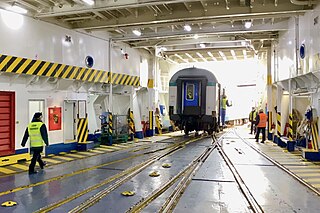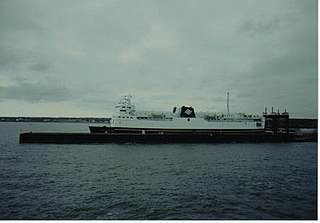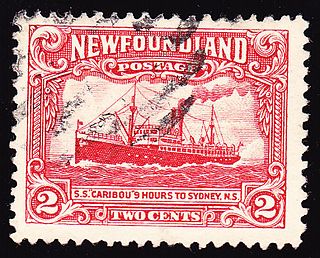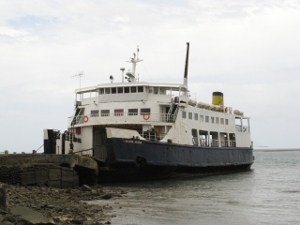
Cabot Strait is in Atlantic Canada between Cape Ray, Newfoundland, and Cape North, Cape Breton Island. The strait, approximately 110 kilometres wide, is the widest of the three outlets for the Gulf of Saint Lawrence into the Atlantic Ocean, the others being the Strait of Belle Isle and Strait of Canso. It is named for the Italian explorer Giovanni Caboto.

Marine Atlantic Inc. is an independent Canadian federal Crown corporation which is mandated to operate ferry services between the provinces of Newfoundland and Labrador and Nova Scotia.

Channel-Port aux Basques is a town at the extreme southwestern tip of Newfoundland fronting on the western end of the Cabot Strait. A Marine Atlantic ferry terminal is located in the town which is the primary entry point onto the island of Newfoundland and the western terminus of the Newfoundland and Labrador Route 1 in the province. The town was incorporated in 1945 and its population in the 2021 census was 3,547.

CN Marine was a Canadian ferry company headquartered in Moncton, New Brunswick.

The Newfoundland Railway was a narrow-gauge railway that operated on the island of Newfoundland from 1898 to 1988. With a total track length of 906 miles (1,458 km), it was the longest 3 ft 6 in narrow-gauge system in North America.
Terra Transport (TT) was the name for the Newfoundland Transportation Division, a wholly owned subsidiary of Canadian National Railway (CN), created in 1979 as a means to organize the company's operations on Newfoundland.

A train ferry is a ship (ferry) designed to carry railway vehicles. Typically, one level of the ship is fitted with railway tracks, and the vessel has a door at the front and/or rear to give access to the wharves. In the United States, train ferries are sometimes referred to as "car ferries", as distinguished from "auto ferries" used to transport automobiles. The wharf has a ramp, and a linkspan or "apron", balanced by weights, that connects the railway proper to the ship, allowing for tidal or seasonal changes in water level.

M/V William Carson was a CN Marine passenger/vehicle icebreaker ferry named in honour of Newfoundland colonial politician William Carson.

MV Caribou was a Marine Atlantic passenger/vehicle ferry which operated between the islands of Newfoundland and Cape Breton in eastern Canada.

MV John Hamilton Gray was an icebreaking railway, vehicle, and passenger ferry which operated across the Abegweit Passage of Northumberland Strait, connecting Port Borden to Cape Tormentine between 1968–1997.

Sadko was a Soviet icebreaker known for its role in scientific expeditions in the Arctic. Built as SS Lintrose in 1913 for ferry service in Newfoundland, she was sold to the government of the Russian Empire in 1915 and renamed Sadko. In Russia, she was used as a freighter in the Arctic before sinking in 1916.

SS Caribou was a Newfoundland Railway passenger ferry that ran between Port aux Basques, in the Dominion of Newfoundland, and North Sydney, Nova Scotia between 1928 and 1942. During the Battle of the St. Lawrence the ferry participated in thrice-weekly convoys between Nova Scotia and Newfoundland. A German submarine attacked the convoy on 14 October 1942 and Caribou was sunk. She had women and children on board, and many of them were among the 137 who died. Her sinking, and large death toll, made it clear that the war had really arrived on Canada's and Newfoundland's home front. Her sinking is cited by many historians as the most significant sinking in Canadian-controlled waters during the Second World War.

German submarine U-69 was the first Type VIIC U-boat of the German Navy (Kriegsmarine) during World War II. This meant that compared to previous U-boats, she could travel further afield for longer, with a payload of fourteen torpedoes, an 8.8 cm (3.5 in) deck gun for smaller vessels and a flak gun for use against aircraft. U-69 was very successful, sinking over 72,000 gross register tons (GRT) of Allied shipping in a career lasting two years, making her one of the longest surviving, continuously serving, U-boats. Her most notable attack was on the civilian ferry SS Caribou, which sank off the coast of Newfoundland in October 1942, killing 137 men, women and children. She was rammed and sunk by HMS Fame on 17 February 1943.

The MS al-Salam Boccaccio 98 was an Egyptian Ro/Ro passenger ferry, operated by El Salam Maritime Transport, that sank on 3 February 2006 in the Red Sea en route from Duba, Saudi Arabia, to Safaga in southern Egypt.
M/V Christmas Seal was a Canadian medical ship operating in Newfoundland from 1947 until 1970. Formerly a United States air-sea rescue vessel during World War II, she later served as an oceanographic research platform before sinking in 1976.

MV Atlantic Vision is a fast ro-pax ferry owned by the Estonian ferry company Tallink, under charter to Canadian operator Marine Atlantic. In February 2015, Marine Atlantic announced that the lease on the vessel had been renewed until November 2017 for a cost of Can$40 million. It was subsequently extended again, and the vessel is under Marine Atlantic control through November 2019. Atlantic Vision operates on Marine Atlantic's services between North Sydney, Nova Scotia, and the Newfoundland ports of Channel-Port aux Basques and Argentia, Placentia.

MV Pelagitis is a roll-on/roll-off (Ro-Ro) ferry formerly operated by Marine Atlantic from North Sydney, Nova Scotia to Channel-Port aux Basques, Newfoundland, Canada. The vessel was completed in 1978 by Hyundai Shipbuilding Company Limited in and delivered to the Stena Line which operates in Northern Europe. She was sold on 12 March 2010 and given her current name Pelagitis.
The Alphabet Fleet was a fleet of vessels owned and operated by the Reid Newfoundland Company as part of the provisioning of the 1898 Railway contract between the Dominion of Newfoundland and the Reid Newfoundland Company. The vessels were named after places in Scotland, the native homeland of Sir Robert Gillespie Reid, founder of the Reid Newfoundland Company.

The MV Princess Ashika was an inter-island ferry which operated in the South Pacific kingdom of Tonga. This motorised vessel (MV) was built in 1972, and began sailing the Tongan route on 7 July 2009 only to sink less than a month later on 5 August. Official figures released by Operation Ashika on 19 August 2009, confirmed that 54 men were rescued, and 74 people were lost at sea. These include two bodies recovered and 72 missing, including five foreign nationals. Two of the missing passengers remain unidentified.

MV Blue Puttees is a Ro-Pax passenger/vehicle ferry operated by Marine Atlantic between the islands of Newfoundland and Cape Breton in eastern Canada. She is named after the nickname of the Royal Newfoundland Regiment.

















